Costa Rica boasts unforgettable fishing and ecotourism experiences for all who visit
For decades I have wanted to visit Costa Rica. It seemed that almost everyone I know had traveled there and loved the experience. So, when John Burrell, President and CEO of High Adventure Company, invited me to go on a scouting trip to check out a possible new opportunity for High Adventure Company clients, I was stoked. One thing I have learned this year is that if a location is on John’s list, it is a sure bet that it will be unforgettable. With that in mind, it was off to the airport.
After an easy ride to San José, Costa Rica’s capital, we jump aboard one of Sansa Air’s Cessna Caravans for the hour-long hop to Crocodile Bay Resort in Puerto Jiménez on the Osa Peninsula. As a pilot, I love small planes, and the view of the coast and Golfo Dulce, which separates the peninsula from the rest of the country, is spectacular. It sets the stage for a perfect arrival. It is a short two-minute ride from the local airport to the resort.
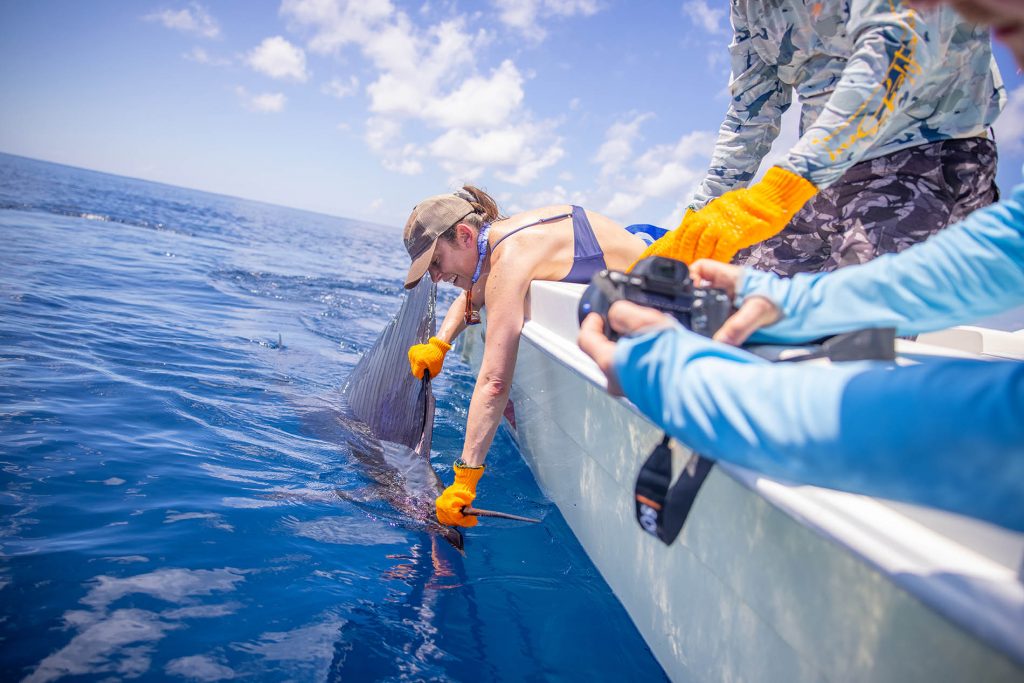
Crocodile Bay Resort is known for its sport fishing, but also for its ecotours. Today’s version of the resort is an unpretentious campus composed of a main building surrounded by lodging units, most of which are a few decades old. (This won’t be the case for long, but we will get to that later.) Upon arrival, we are greeted by owners and brothers Beau and Cory Williams and the resort’s front end manager, Juan. We have never met, but it feels as if we are old acquaintances. We settle in, indulge in dinner and drinks, and head off to bed. It will be an early morning.
The next day starts as planned at 5:30 a.m. with a breakfast of eggs Benedict and oatmeal, just the sort of hearty meal needed for this day. An hour later, John and I, along with Tania Tuttle, also of High Adventure Company, head to one of the resort’s Boston Whalers, and after a quick bit of bait gathering, we are off on the ride to deep water. Our hope is to catch some sailfish on a fly rod, and after a lifetime of fly-fishing for trout and smallmouth bass for me, it seems an almost impossible feat to imagine. The sailfish, part of the billfish family, is one of the fastest marine animals in the world.
After about 90 minutes, we are setting the outriggers and putting the bright colorful teasers into the water.
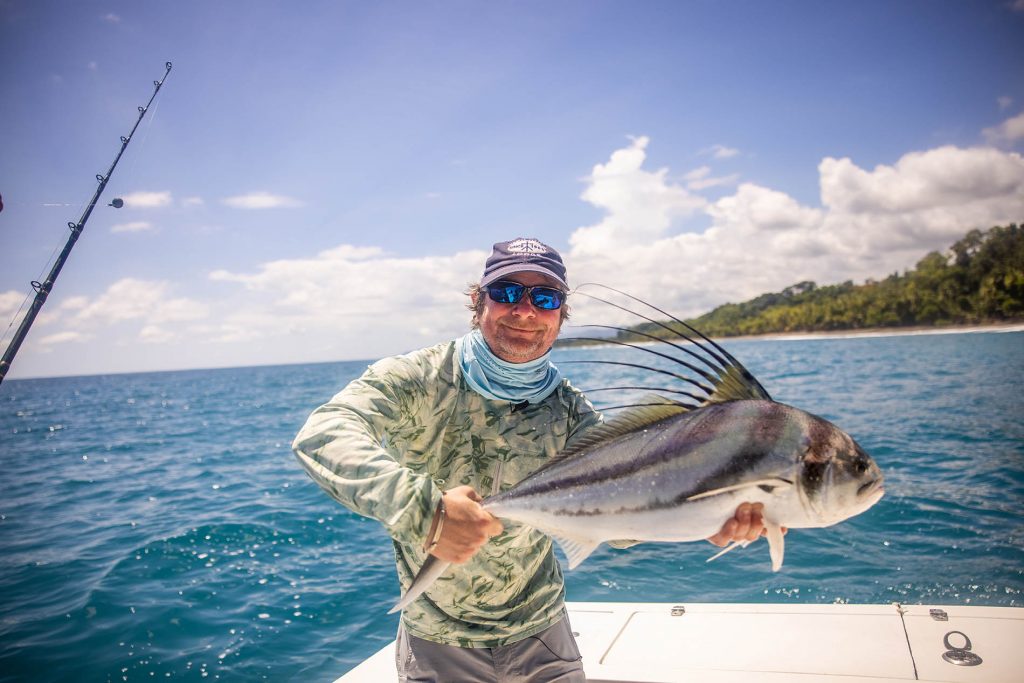
To catch a sailfish on a fly rod you first need to locate the fish and then tease it close enough to the boat to make an appropriate cast. We troll along, patient yet anxious. John climbs into the tower with the captain, scanning the horizon for any sign of activity. It’s not long before we raise a nice sailfish and Tania takes the rod, eager to land her first. We watch as the sailfish jumps magnificently trying to throw the hook while Tania battles to keep the line taut, John calmly coaching her. As she brings the fish to the boat, she holds its bill, and the smile on her face says it all. This remains our sole catch of the day, but between the excitement of our first catch and the views of Costa Rica’s coast, we can’t help but feel already invigorated by the experience.
The intensity of the sun can take it out of you at the latitude, so after a quick swim to cool off, I am happy to slide into the bar for cocktails with my friends before dinner. I once read that no problem arrives without a solution in its hands, and it is in locking myself out of my room, hot and ready to cool off and relax, that I connect with Olimpia. In my moment of minor distress, this wonderful woman smooths my ruffled feathers, tells me that she loves me—I think she says that to everyone—and that she will make sure that everything is okay. When that kind of emotion is genuine, even the most stressful of situations can seem to melt away in an instant. Olimpia not only loves her guests, but serenades them in a cappella versions of local songs. She is the perfect fit for the bright Costa Rican birds that sing the chorus with her. I am beginning to realize just how special this place can be. There is a certain harmony between the people and the environment. Costa Rica, in a sense, is like traveling back in time to a more balanced world. After the past year of constant warning about contagion, it seems being here has slowed me down enough to realize that heartfelt love is contagious as well.
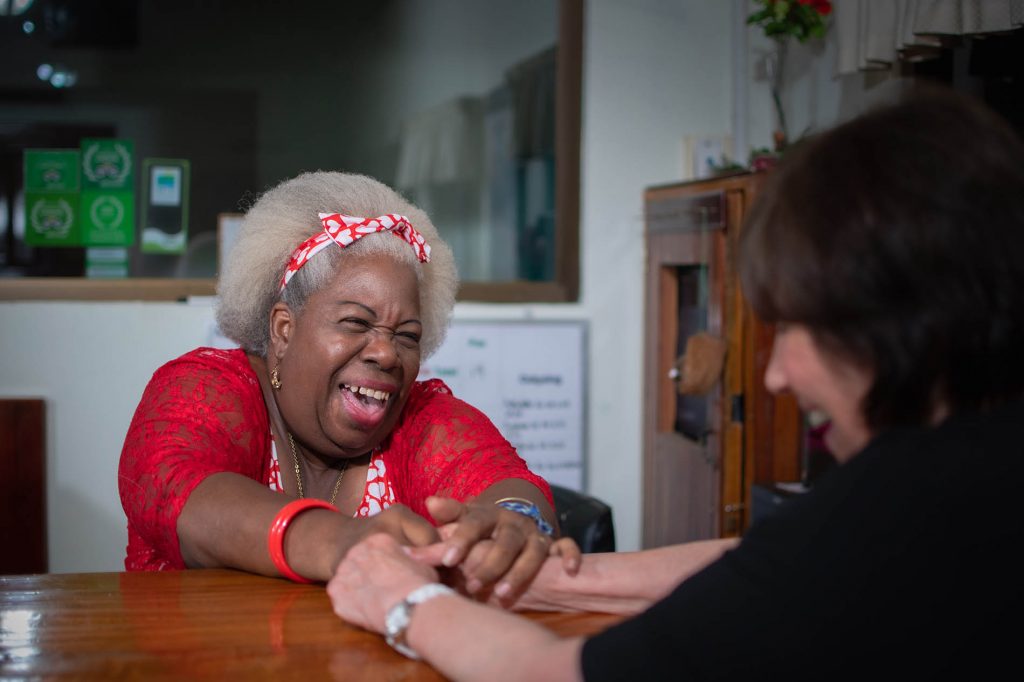
I carry that feeling with me as I enter the bar in search of my friends. If you have ever been to a fish-camp bar, you know how truly magical it is. And although Crocodile Bay is far more than a fish-camp, the feeling of the group this evening is one that epitomizes that warm feeling you get when everyone seems to knows each other. Put a group of fishermen in a bar and it will not be long before the stories are flying and the bonds of new friendships are being forged. Today will be no different.
Sitting at the bar, I reflect on some of my past experiences with my new friends. I enjoy storytelling. Hell, it’s my life. But when John begins a tale, it seems as if even the birds quiet to listen. Everywhere we go, John seems to know someone, and they always seem to have some past experience in common. The stories are rich, filled with laughter and driven by vivid images of high intensity and great adventure. They flow like good bourbon, and you can’t help but be entertained.
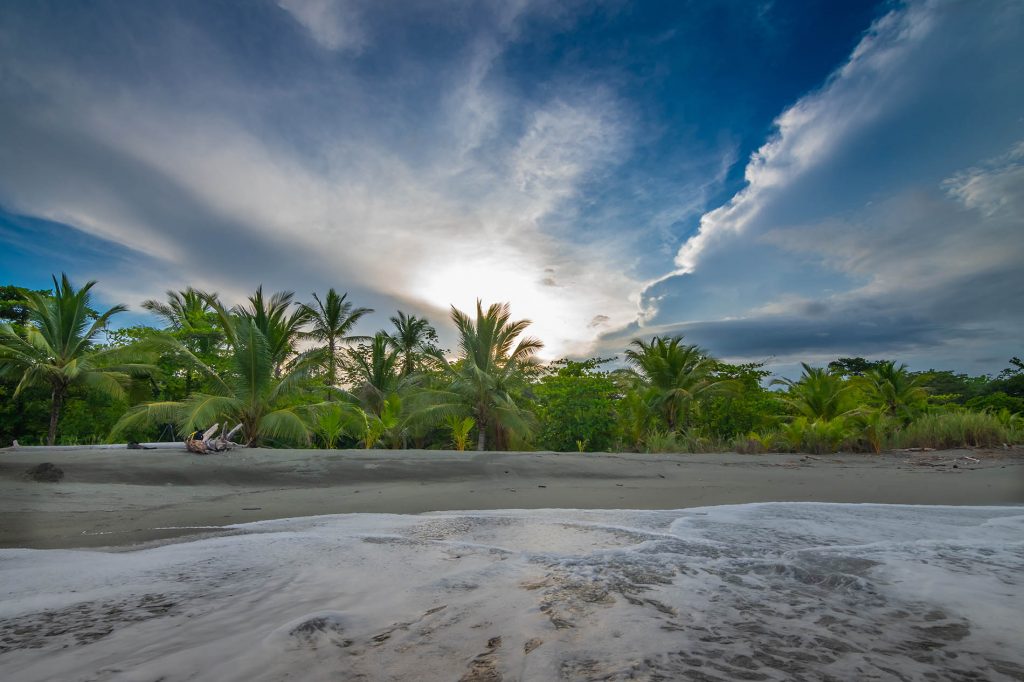
The day’s fishing stats are up on the board, and the two gentlemen across the bar, James and Sean, seem to have set the standard for the day. But this is not a tournament, and I am enjoying their obvious enthusiasm for fishing, listening to their tales of past catches. The two are long-time fishing buddies who have been coming to Crocodile Bay to fish for around 10 years, and they are giving us some insight into what to expect the next day. We’ve made fast friends, and despite our slow day on the water, they assure us that tomorrow will be better. I love this about a true sportsman, the eternal optimism that tomorrow will bring that ultimate catch.
While sailfish were our species of interest on arrival day, they won’t be our only on this trip. Costa Rica’s biodiversity is unrivaled; National Geographic has called it “the most biologically intense place on Earth.” We get to witness elements of this fact firsthand, and on our second day, at the suggestion of our new friends, we head off in search of the roosterfish.
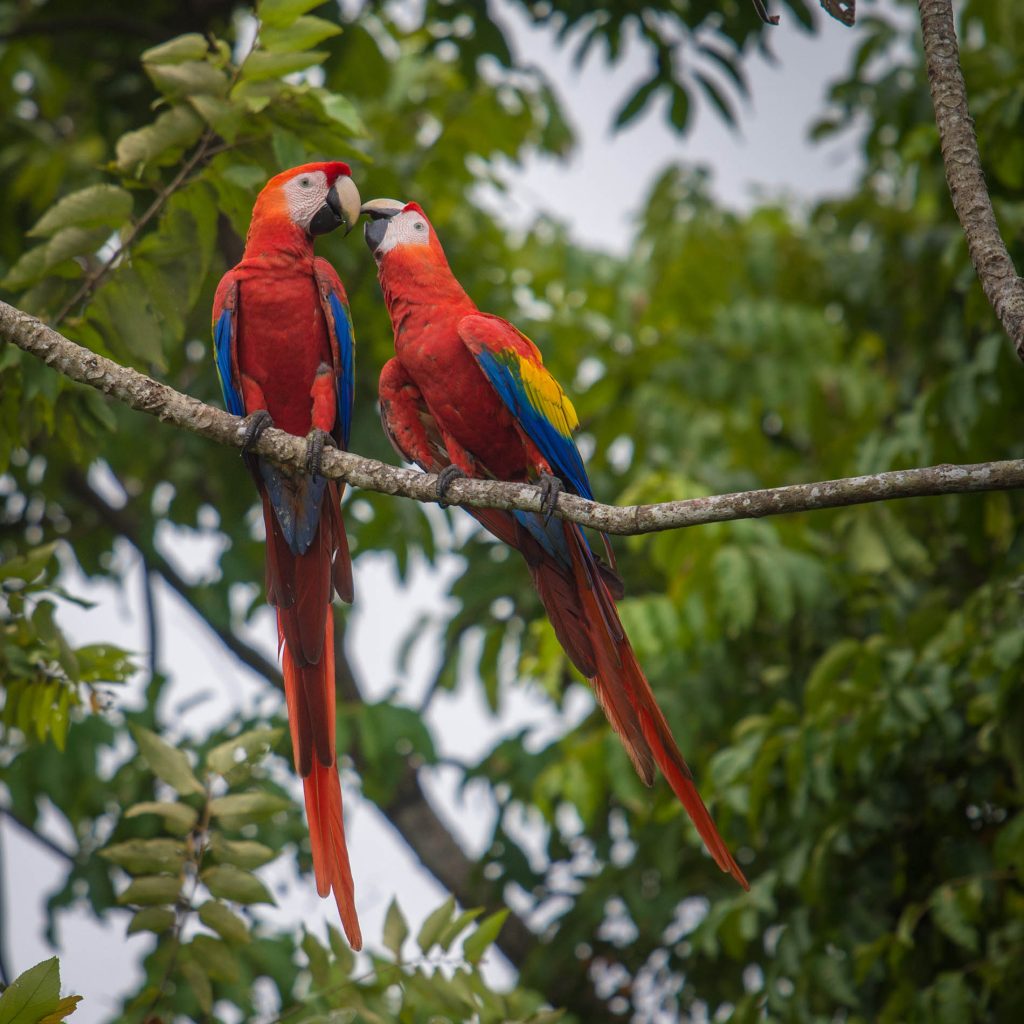
If you’ve never seen a roosterfish, it is quite the sight. Seven long spines protrude out of its dorsal fin. It’s aggressive and hard-hitting, but it makes for a memorable fishing experience. These fish can grow to be nearly 60 pounds in size, but you would never know its weight the way it jumps and darts about the water. This is my first time attempting to catch one, and I’m surprised to find that this gorgeous fish can even be caught on top water with poppers. For the less experienced, it can be a more fast-paced bite with the opportunity to learn to better handle a rod and reel. I am a reasonably experienced fisherman, but I have never seen a roosterfish. I am ready for the opportunity to catch a monster.
The bites are slow with no roosterfish in sight, so we motor in to about 100 yards off the beach, the ocean bottom 100 feet below us. We bait up and cast our lines. With plenty of live bait we spend the next several hours catching and releasing some nice roosters. Just as we thought it was over, one of the other Crocodile Bay captains who was fishing nearby floated us some more bait in a small net. We all enjoy landing several nice fish and eventually call it a day.
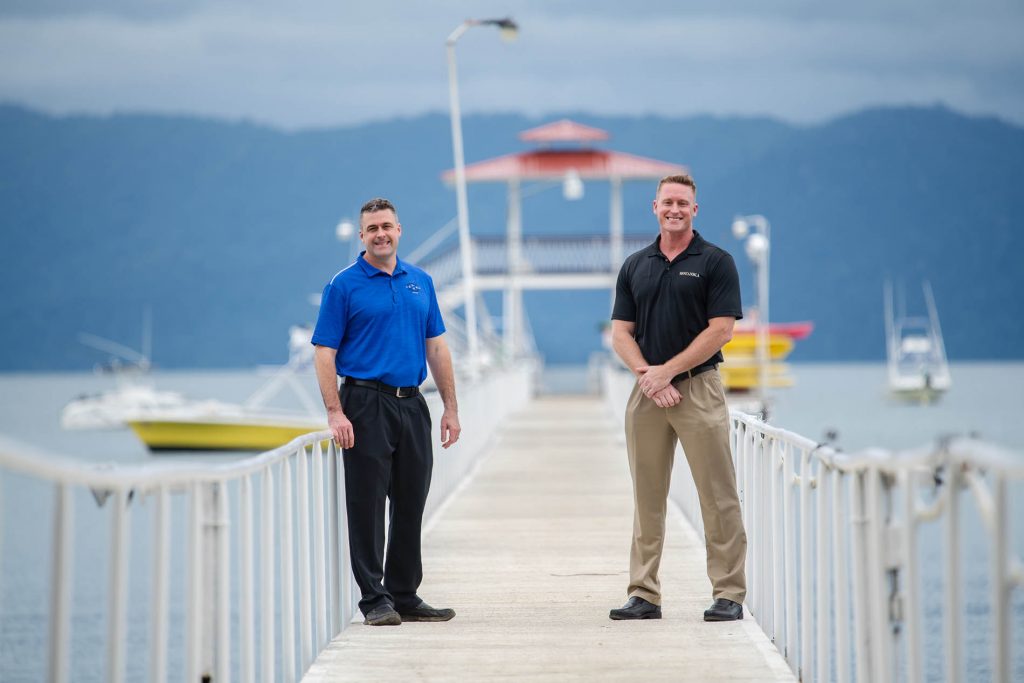
We have the opportunity to spend a little time with the resort owners, Beau and Cory, and I’m fascinated listening to their story. They first visited Costa Rica in 1992 on a family vacation that included three generations. I can remember a trip or two when my Dad’s father, Charles Garland Sparks, came along; it was always a treat to get three generations together. For Beau and Cory’s family, it was, in Beau’s words, an “unexpected opportunity for family bonding,” but that bonding was so rejuvenating that the family kept coming back. In 1998, their father’s 1,000-acre development near San Francisco was taken by eminent domain by the state for use as a landfill. It upset him so much that he took the money and the boys and moved to Costa Rica, a place he characterized as appreciating them being there. One of the ideas was to offer air conditioning, which at the time was not available at most Costa Rican fishing resorts. I guess that sometimes it’s the little things that make the biggest difference.
The brothers worked on the crews to help build the first phase of the resort, which is now home to the largest fishing fleet in the country. They currently have 50 boats and are growing fast. Right now, they are in the construction phase to add 100 new privately owned condos—or Rainforest Residences—as well as a new clubhouse, spa, pool, and other amenities. The overall operation, dubbed Botánika Osa Peninsula, will fly Hilton Hotel’s brand, Curio Collection by Hilton. Curio will rent the rainforest condos when not in use by the owner. (And let it be emphasized that this will not be a timeshare; rather it will be direct-fee, simple ownership of the units.) While this is a Hilton hotel, Aqua-Aston Hospitality, a Honolulu-based company that is now an indirect subsidiary of Marriott Vacations Worldwide Corporation, will be its operator. This is an unusual partnership, but one that Beau says will help them continue to receive clients from across the world.
With increased capacity will come a new world-class marina, with slips capable of handling yachts up to 250 feet in length. The current Crocodile Bay Resort will become Crocodile Bay Marina and will transform into a seaside village.
Beau relays all of this over a few cups of coffee. It’s the fish-camp feel again. Everyone, especially the owners, is warm and open to a good conversation. If you are looking for a vacation getaway with great management, this might be your ticket. But more importantly, if you are looking for a solid investment in a resort-type rental, I highly recommend giving Beau and Cory a call. The first of the Rainforest Residences sold out in almost no time, and I suspect the same will be the case on the remaining.
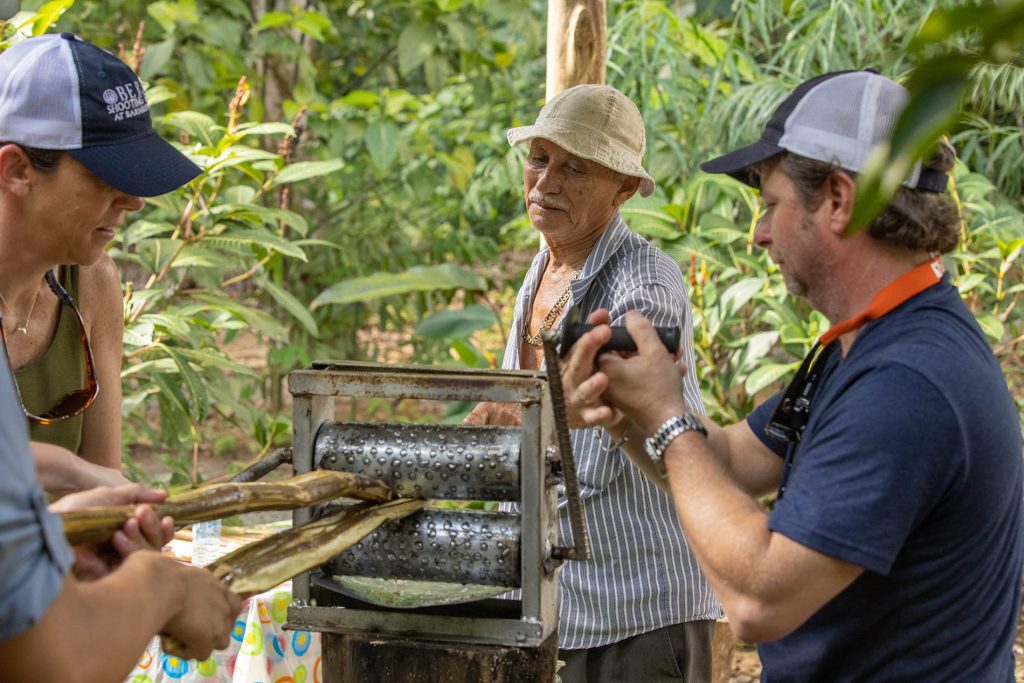
On our last day, we wake up early and enjoy a trip with ecotourism guide Dennis Valverde to a forest near Corcovada National Park, one of the most bio-diverse regions. Minutes into the drive, we already see two scarlet macaws feeding in the trees. Their colors are spectacular. We arrive at our first stop of the ecotour, which is a visit to Dennis’s family’s farm, a totally unexpected treat. We are greeted by his grandfather, a colorful looking fellow who I am sure has a story to tell. We immediately see several sloths including a mother and baby, white faced monkeys, and a virtual cornucopia of plants and insects. We hike about 30 minutes, before arriving at their gazebo. Dennis begins cutting a white pineapple which ends up being the best I have ever tasted. The white pineapple plant only produces one fruit in its entire lifetime. I savor every last piece. To top this visit off, Dennis’s grandfather brings about 20 pieces of sugar cane over, and after some whacking to break the joints, teaches John, Tania, and me how to extract the juice to make a delicious sugary drink. It is so reminiscent of a simpler time; check out the video of the process at cityviewmag.com/costarica.
From there we are off towards Corcovada. On the way, Dennis brings us by the most unusual tree I have ever seen. Made up of a latticework of small tendril-like trunks, it is easily 50 feet across at the base and shoots up hundreds of feet into the air. Standing inside of its lovely feet, you can feel its power. The forest here is so lush and the canopy is so dense that very little sunlight reaches the forest floor. It’s a biologist’s dream, and John, who is a wildlife biologist, is constantly comparing notes with Dennis. I listen and hope to pick up a new fact or two. Dennis, who is also a phenomenal photographer, shares with us many of his photos depicting everything from frogs to lemurs, some of which are pictured here.
The experience is so rich, but all good things must come to an end so we head back to Crocodile Bay for our final night. However, it doesn’t disappoint—how could it? At dinner, we meet local legend Todd Staley, the very first employee of Crocodile Bay, who joins us for dinner. Todd is not only a world class captain, but he also helps run La Federación Costarricense de Pesca, or FECOP, an organization dedicated to helping manage the Costa Rica fisheries and aid in policing illegal long-line activity in and near shore waters. The effects of this long lining practice can be devastating to the quality of life for billfish, and it’s good to know that they are actively fighting to keep the fisheries sustainable.
Fishing is one, if not the top, of my favorite things to do. And Costa Rica fishing is nothing short of amazing. However, I can’t stress enough how important it is to not miss out on the ecotours. Both are an essential part of any Costa Rica trip.
We only had a few days at Crocodile Bay, though I would have enjoyed having a few weeks instead. Cityview is planning to go back on a combination photo safari and fishing expedition. If you would like to join us and be part of the creative team on our stories, please get in touch, and we will give you the details on this trip along with our upcoming African safari photo tour. If you just want to book a trip and want to be sure all the details are perfectly in order, contact the High Adventure Company. You can find more information on our website.

Comments are closed.